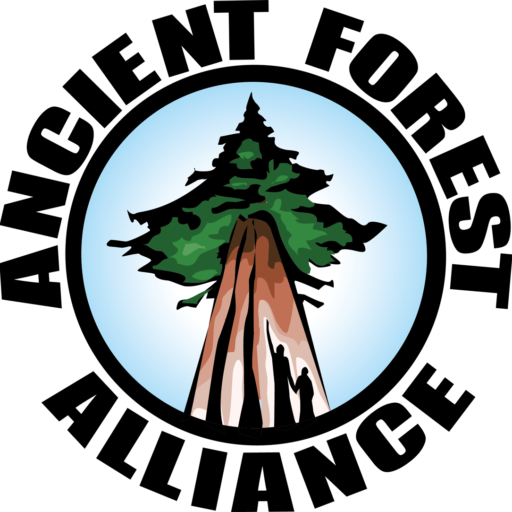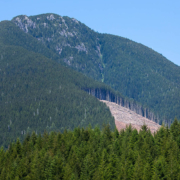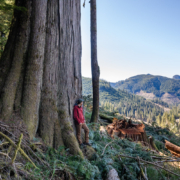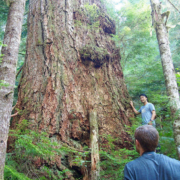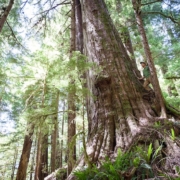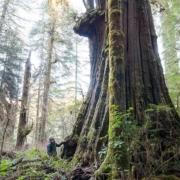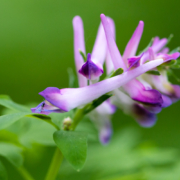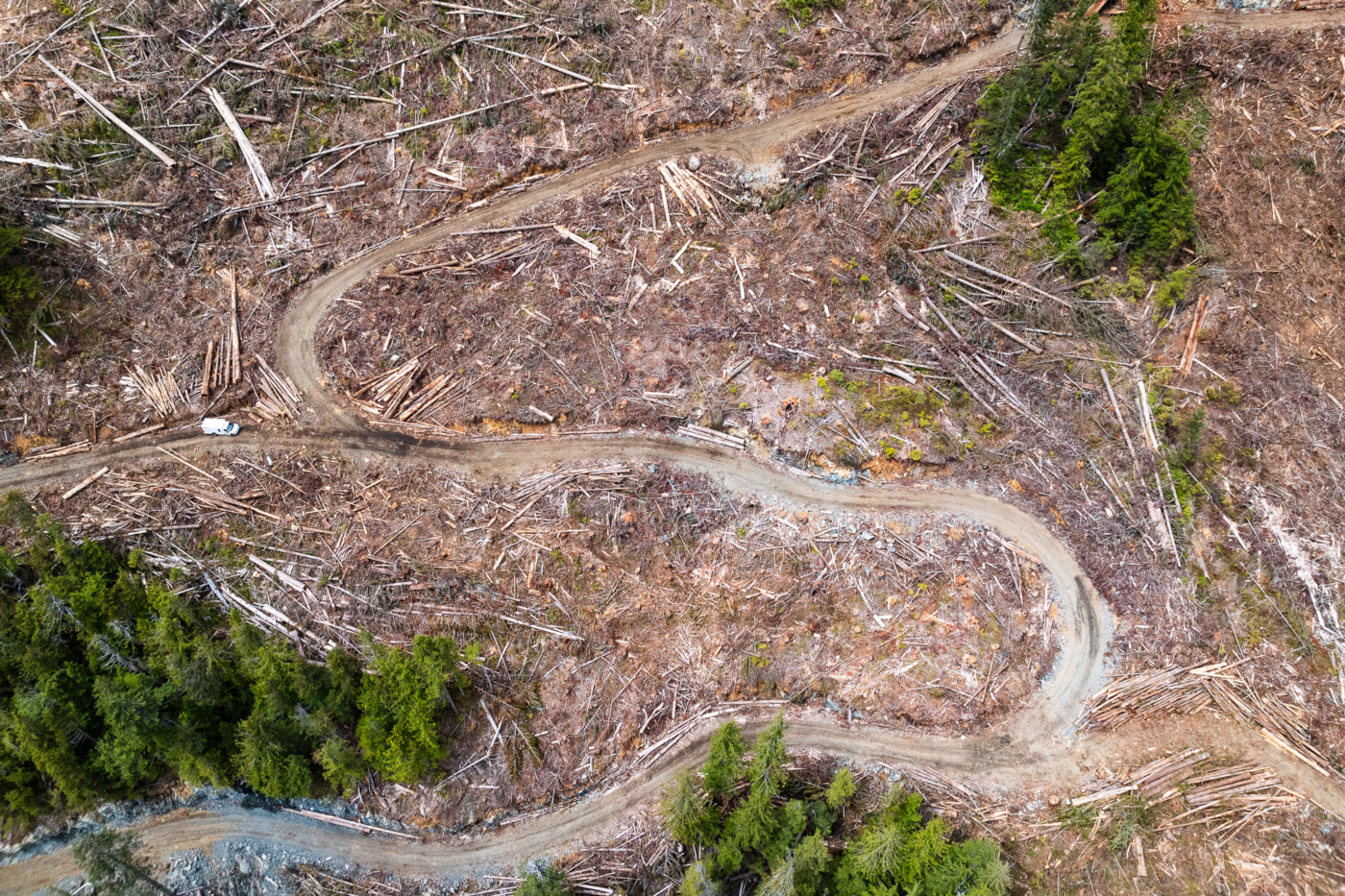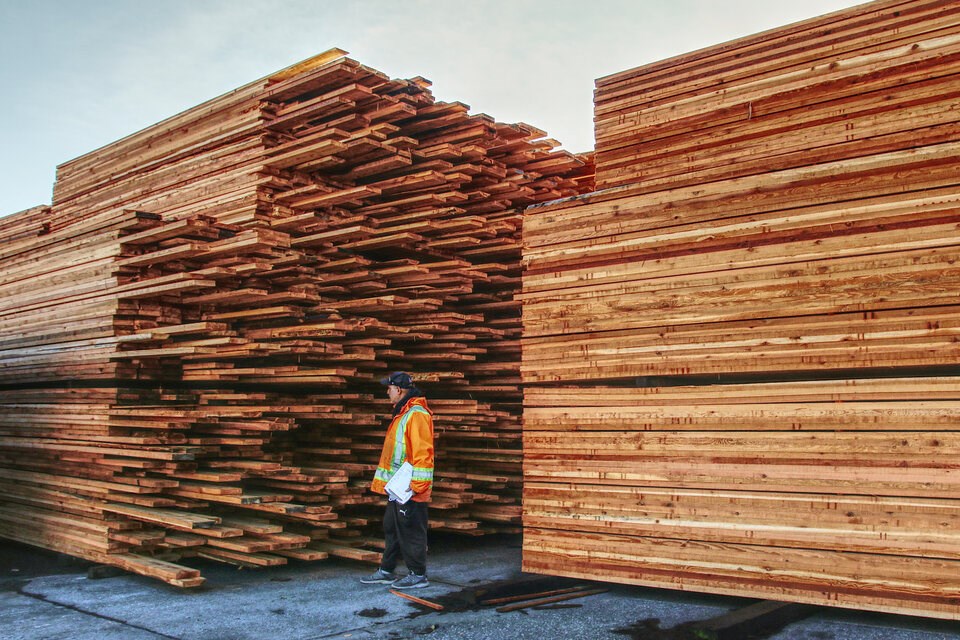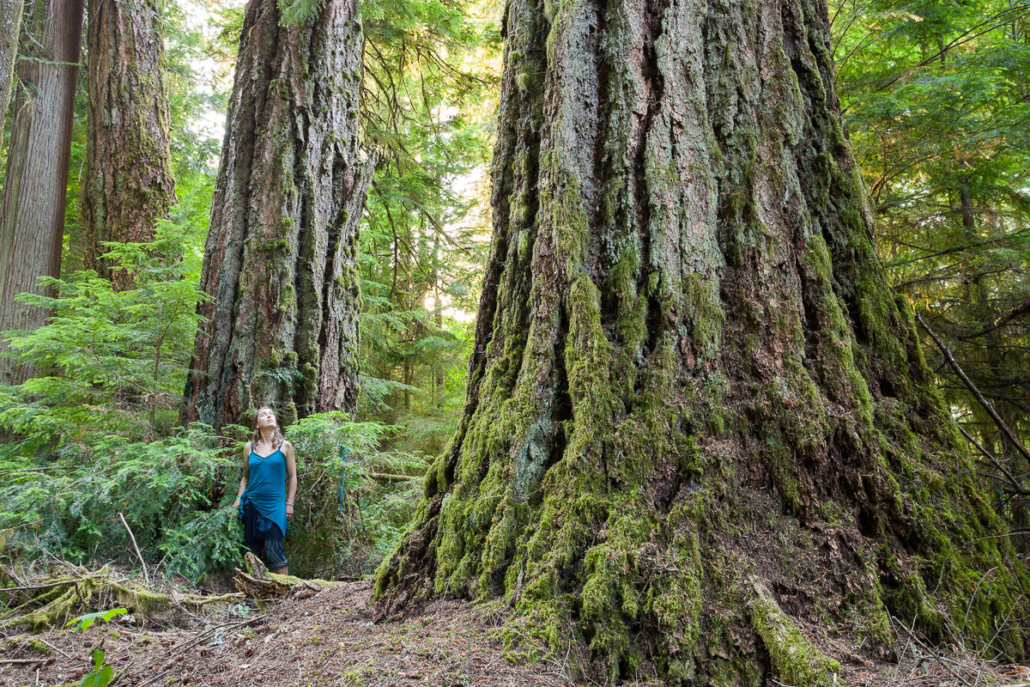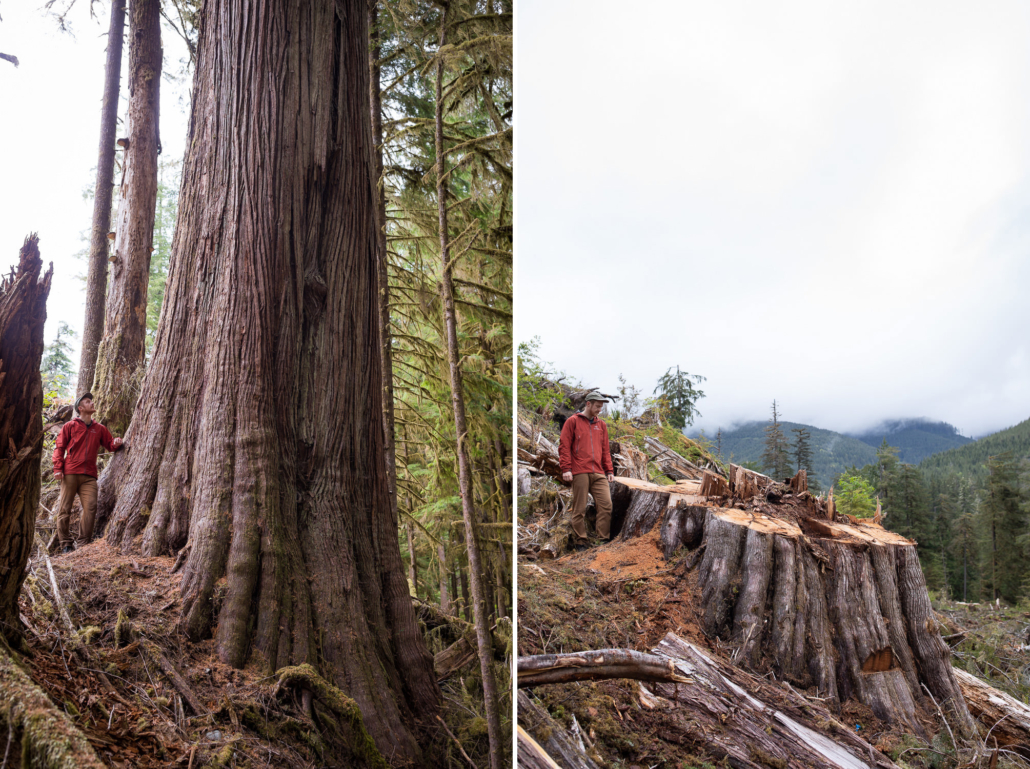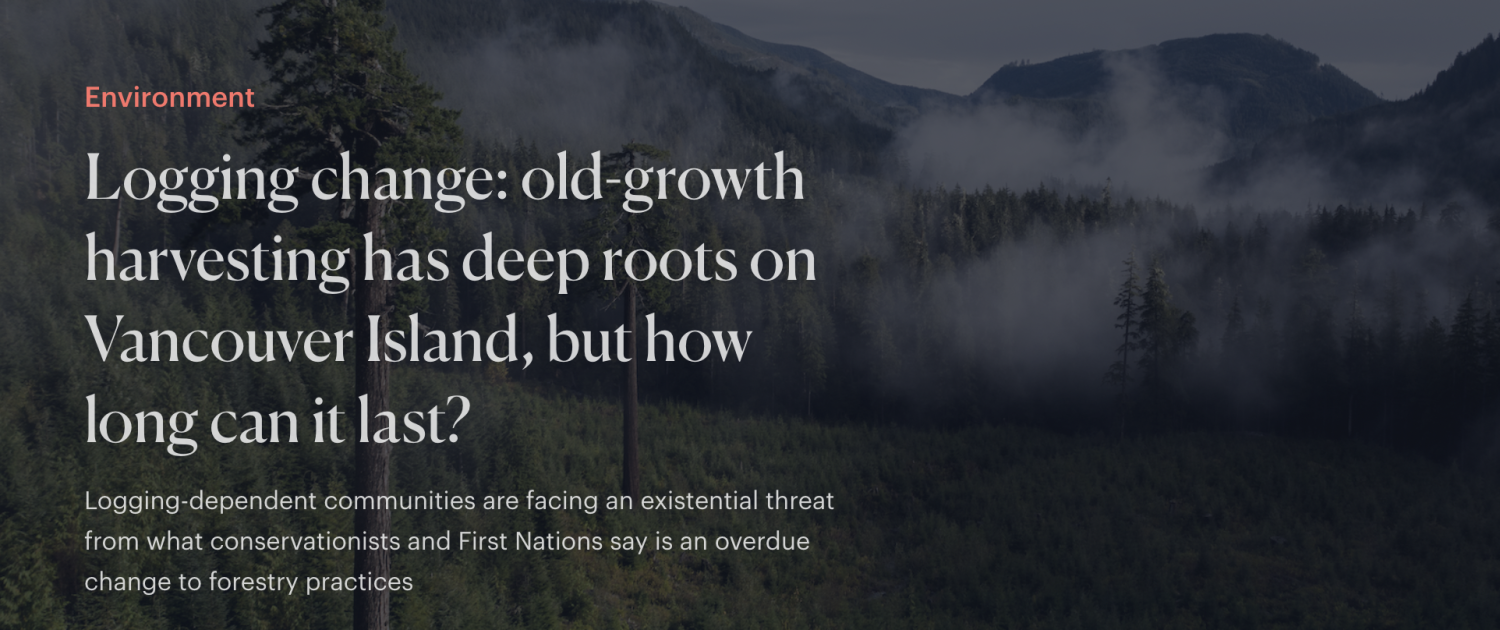 Jan 31 2021
Jan 31 2021Logging change: old-growth harvesting has deep roots on Vancouver Island, but how long can it last?
Capital Daily
January 31, 2021
Logging-dependent communities are facing an existential threat from what conservationists and First Nations say is an overdue change to forestry practices.
If there’s a stand of ancient trees anywhere on Vancouver Island, chances are TJ Watt has seen and photographed it. Watt is cofounder of Ancient Forest Alliance, which has taken him to every corner of the Island in search of big trees.
In 2018, Watt was scouring satellite imagery on his laptop when he stumbled across an application to cut down old growth in the upper Caycuse River watershed, in the mountains above Lake Cowichan and Nitinat Lake. He hopped into his trusty van, headed north, and navigated a maze of bumpy logging roads that led him to a breathtaking grove of western red cedar giants that he thought would be a candidate for conservation.
He returned twice: once to document the forest as it was, and a second time to witness what remained after it was logged.
Fallers, working for Surrey-based Teal Jones Group, left a clearcut where a 33-hectare stand of ancient forest once stood. Watt’s stark before-and-after images triggered a storm of media and public interest that was surprising, even for a conservation photographer accustomed to shooting big trees and stumps with impact in mind. Some of the tree stumps measured four meters in diameter. Watt says he stopped counting rings on one of them at 800 when he got to its hollow core, leading him to estimate some of the specimens to be at least 1,000 years old. He was alarmed, but not surprised.
“I think it’s criminal that this is happening. To put it into perspective, it would be the year 3020 before we would ever see trees or a forest like that again in the same place,” Watt says, adding that he doesn’t oppose logging—he believes it’s time to make the shift into harvesting mostly second growth. “They will never have the chance to become old-growth forests again.”
The Caycuse logging controversy underscores an uncomfortable truth: that the province’s oldest, most biodiverse, and increasingly rare forests are also some of the most commercially valuable to the logging industry. It’s a political hot potato for the NDP government, which traditionally courts two often-conflicting constituencies. On the one hand, labour, resource communities, and powerful lobbies, like the Truck Loggers Association, which represents more than 500 companies and contractors, will fight hard to protect jobs and land access. On the other hand, conservation groups like the Ancient Forest Alliance, scientists, and an environmentally conscious public are crying foul as industry continues to cut down thousand-year-old trees.
The tension has resulted in plenty of discussion. In April 2020, independent scientists Rachel Holt, Karen Price, and Dave Daust published B.C.’s Old Growth: A Last Stand for Biodiversity, in which they dissected the BC government’s accounting of the province’s old-growth resources. The results were alarming. After parsing out old forests containing small trees (typically found on high-elevation, boggy, or nutrient-poor sites), the researchers found that just 3% of the 13.2 million hectares of old growth habitat in BC is suitable for growing massive trees like those felled in the Caycuse.
Of the small percentage of land area in which the biggest, strongest old trees can possibly grow, 97% has already been logged. What’s worse is that BC’s main protection tool, Old Growth Management Areas (OGMAs), are often too small to have any sustained biodiversity value and are poorly regulated.
Sonia Furstenau, leader of the Green Party of British Columbia and Cowichan Valley MLA, likens the continued logging of rare old growth in BC to an African nation deciding to permit the hunting of white rhinos.
“Our government would be outraged,” Furstenau says. “We should be just as outraged by what’s happening to our old growth forests. The NDP is moving the needle in the wrong direction.”
Valuable resources; invaluable ecosystems
Watt had a life-changing moment 15 years ago when he stood at the base of a giant western red cedar in the upper Walbran Valley, which had been the focus of anti-logging protests. Sun rays pierced the canopy and landed in luminescent pools on the sword ferns and mossy forest around him. The experience inspired him to pick up a camera and dedicate himself to conservation of these long-lived temperate rainforests that are engines of biodiversity.
Three-quarters of all mammal species and two-thirds of amphibians found in BC live in coastal rainforests. For botanists, the coastal-like forests found in the interior are a frontier of discovery. Darwyn Coxson, a University of Northern British Columbia biologist, has been studying old cedar-hemlock forests in the Robson Valley along with Trevor Goward and Curtis Bjork, scientists affiliated with UBC’s Beatty Biodiversity Museum. Over the past six years, the researchers have catalogued more than 2,400 plant species, including dozens previously unknown to science.
“It shows just how little we know about this ecosystem,” says Coxson.
BC’s temperate rainforests are also powerful allies in the fight against climate change as they are able to sequester more carbon than any other forest type in the world.
As precious as they may be to science and the climate, they’re also extremely valuable as timber. Old-growth forests (by some definitions, those that are 250 years or older on the coast and 140 years in the interior) have traditionally anchored BC’s forest sector, which contributed $13 billion to the provincial GDP in 2016.
The supple, rot-resistant wood of old growth western red cedar, the iconic BC rainforest species and the official provincial tree, is a highly sought-after commodity. The rarer it becomes, the more valuable it is to loggers. In the summer of 2019, western red cedar was fetching roughly $360 per cubic metre on the international market, more than twice the amount being paid for Douglas fir, the next most valuable BC wood export.
During the 2017 provincial election campaign, John Horgan’s NDP made a vague promise to use the ecosystem-based management being applied in the Great Bear Rainforest as a model for sustainable management of old-growth forests provincewide. But the public was growing impatient. Controversial logging in the Nahmint Valley, 30 kilometres southwest of Port Alberni, and uncertainty over the future of interior rainforest like the spectacular Incomappleux Valley near Glacier National Park (where biologists have discovered dozens of new lichen species) added fuel to the ongoing debate.
In July 2019, the provincial government commissioned an Old Growth Strategic Review, led by two veteran professional foresters: Al Gorley, former chair of the Forest Practices Board, and Garry Merkel, a member of northwestern BC’s Tahltan Nation and a natural resources specialist. Merkel is a candid, independent thinker. He’s been around long enough to see more than one government report come and go but hasn’t given in to cynicism.
However, it’s not the first time a ruling NDP party has tackled old growth logging practices. In 1992, Mike Harcourt’s government unveiled the Old Growth Strategy, but the report gathered dust while critical aspects of it were “either discarded or partly implemented,” Merkel told Capital Daily over the phone from his home office in Kimberley. Had this report been fully implemented more than 20 years ago, Merkel believes BC’s old-growth forests would be in a much more stable position. So it was with a sense of urgency that he and Gorley hit the road late in 2019, touring the province for two months and meeting with loggers, First Nations, conservationists, and community members.

Last April, they submitted their report, A New Future for Old Forests. It pulls no punches. Not only does it call for the suspension of logging in BC’s most at-risk old forests, it’s also an indictment of entrenched land-management practices that treat forests like industrial tree farms.
“We are recommending a paradigm shift, from a timber-focused regime that views ecological health as a constraint, to an ecological focus with timber as one of the many benefits,” Merkel says. “Everybody knows that the current system is not working—one that is a trade-off between biodiversity and timber values.”
Merkel and Gorley made 14 recommendations to be enacted by 2023. Topping the list is immediate engagement with First Nations across BC on a government-to-government basis and the provision of much-needed resources to support the forestry industry’s transition. Also among the recommendations are a call for more government transparency, establishing clearly defined biodiversity targets, and also helping timber-based communities adapt to forest management changes.
Merkel concedes that it will mean reductions in timber harvesting in some areas of the province.
As a first step last September, BC announced two-year logging deferrals on 350,000 hectares of old growth scattered across the province, including forests in the McKelvie Valley near Tahsis, Clayoquot Sound, and the Incomappleux. In addition, the province committed to increased protection for and expansion of the province’s big tree registry to as many as 1,500 specimens, each surrounded by a 1-hectare conservation buffer. It’s likely too early to judge the province’s response to the report, but Merkel is optimistic.
“I wouldn’t have agreed to do this review if I didn’t believe the government was sincere,”he says.
Katrine Conroy, MLA for Kootenay West and the newly minted minister of Forests, Lands, and Natural Resource Operations, says she is committed to implementing all 14 recommendations, but admits the three-year timeline is ambitious. For example, the province has yet to roll out a plan for government-to-government talks with First Nations about forestry transition and funding, something she says will likely require going to the Treasury Board with cap in hand at a time when public finances are being stretched by the pandemic. Shifting to biodiversity-based forest management provincewide will first require unpacking forest policy—and that, too, will take time and debate.
“This is not just about old-growth trees; it’s also about the ecosystems around them. We need to take a much more holistic approach and think of forestry in terms of high value rather than high volume,” Minister Conroy told Capital Daily in an exclusive interview. “We’re just getting started but we want to build a more sustainable and competitive industry.”
‘We don’t even know how much old growth is left’
Over the past half-century, the Nitnat-based Ditidaht First Nation has witnessed the liquidation of valley-bottom and mountainside ancient forests within its territory, which extends from the rugged coastline between Pacheena Point and Bonilla Point, inland to Cowichan Lake. While the eleventh hour for BC’s rarest old-growth trees approaches, timber-based communities and First Nations like the Ditidaht are stuck in the middle.
One of the old growth review panel’s key recommendations hones in on a critical problem for First Nations provincewide: a lack of capacity and technical know-how to stay on top of industrial activity within their territories.
“Am I concerned? Yes. We don’t even know how much old growth is left on our territory,” said Paul Sieber, the Ditidaht’s natural resource manager. “Industry keeps the information pretty close and it makes it hard for us to respond in a meaningful way to logging plans.”
Sieber’s desk is piled high with reports and documents. He’s perpetually stretched and hasn’t yet found time to peruse Merkel’s and Gorley’s old-growth report. In the early 1990s, heavy logging by a previous tenure holder in the Klanawa River valley, which drains out to the west coast through Pacific Rim National Park, led to landslides, erosion, and damage to a river that once teemed with steelhead and salmon. It angered Sieber then, and it still angers him now. He fears that the recent cutting of old-growth forest in the upper Caycuse River watershed will further damage what is already a heavily logged watershed.

This is a complex time in the relationship between forestry companies and First Nations, who have for too long been bystanders as companies profited from old-growth logging in their territories. They’re late to the party. Many nations, like the Ditidaht have only recently entered into revenue sharing agreements and partnerships with forest corporations. Teal Jones Group and Western Forest Products (WFP) each hold an area-based tenure on Crown land known as a tree farm licence, or TFL, that requires them to pay stumpage fees to the Crown for the right to log within Ditidaht territory. The Ditidaht, through their forestry arm Ditidaht Forestry Ltd, are now logging in partnership with TimberWest, and negotiating with Teal Jones and WFP for long-term timber access and revenue sharing agreements.
The problem, according to Garry Merkel, is that many nations now find themselves in the untenable position of harvesting at-risk old growth to support their businesses.
“We need to find solutions that don’t involve forcing First Nations to shut down or fight to harvest areas they may not agree with,” he says.
A raw deal for small communities
Twenty-five years ago, a small-town tour of Vancouver Island would have been much different than it is today. Timber mills were pumping out lumber in places as remote as Youbou and Tahsis, while high-paying union jobs supported thriving communities and small businesses sprang up around these anchor industries.
TimberWest closed its Youbou operation in 2001, the same year that the mill in Tahsis was mothballed. It was a sign of things to come. In 2003, the then-Liberal government scrapped a Forest Act provision called appurtenance requiring companies with Crown forest tenures to operate mills in communities located within the geographical area of a given tenure. It only added to the decline in manufacturing capacity.
Last May, Langley-based San Group began production at a new $70-million plant in Port Alberni, the first major investment in coastal sawmilling in 15 years. But this is a lonely bright spot: since 1997, roughly 100 mills have shut across BC. Over the past decade, the forest sector has lost more than 22,000 jobs, mostly in lumber and pulp and paper manufacturing.
Campbell River symbolizes the changing economic reality of many Island communities. Between 2008 and 2010, TimberWest shut its sawmill and sawdust, pulp, and containerboard operations, then Catalyst Paper closed its Elk Falls mill. They laid off 700 workers between them and left behind vacant industrial lots on the waterfront north of the city.
Companies are required by law to process BC logs domestically. However, there’s a loophole: if they are unable to secure a fair price after advertising in the domestic market, logs can be sold to foreign mills.
A 2018 study by the Canadian Centre for Policy Alternatives showed the relationship between mill closures and rising raw log exports. Between 2013 and 2016, forest companies shipped 26 million cubic metres of raw logs, and old growth accounted for roughly half of the exports.
The three largest exporters of raw logs are big players on Vancouver Island: Western Forest Products, Island Timberlands, and TimberWest. In 2016, TimberWest, which owns 327,000 hectares of timberland on Vancouver Island, sent more than 2 million cubic metres of raw logs out of the province.
But in Port McNeill, logging still matters. The town’s motto, “Tree Farming Country,” speaks volumes. The “world’s largest burl,” an estimated 30-tonne knot that was cut from a Sitka spruce in 2005, is proudly displayed on the Port McNeill waterfront. When loggers are working, business is booming. That’s why the eight-month bitter labour dispute between Western Forest Products and the United Steelworkers Union that began in July 2019 hit the northern Vancouver Island community hard.
“I’d say 80% of Port McNeill’s economy is either directly or indirectly tied to the forest sector,” Mayor Gaby Wickstrom says.
Port McNeill is one of a dozen members of Forest Friendly Communities, an industry-promoting organization formed in 2016. Wickstrom recalls the strike as one of the darkest periods since she moved to the area 25 years ago to drive a forest industry tour bus. Port McNeill was plunged into a mini recession that impacted everyone, from stylists at Bangles Hair Studio to servers at Tia’s Cafe.
“We had people accessing the food banks who never had to before.”
She worries about the speed of change if the province follows through with the old-growth review panel’s recommendations to transition out of old-growth logging. In a Vancouver Sun op-ed, she argued for “a decision that fairly balances the interests of conservation and the economy.”
That balance, she argues, can’t leave communities like hers behind.
“If there’s going to be a moratorium on old-growth logging, we’re going to need help with the transition,” Wickstrom says. “We want to make sure our community has a voice.”
The members of Forest Friendly Communities definitely have the Truck Loggers Association (TLA) in their corner. Bob Brash, a forester and TLA’s executive director, calls old-growth logging an “emotionally charged” issue.
“Our industry has proven to be adaptable but we need certainty around the working forest land base. We’re still waiting for the government to conduct a socio-economic analysis on the impact of a moratorium on old-growth logging, ” Brash says, noting that 50 million hectares of BC forests have been certified since 2002 by third-party sustainability auditors like the Forest Stewardship Council. “Government has to get this right and it has to be based on science, not emotion.”
Garry Merkel agrees—and the science is clear, he says. High-productivity old-growth forests in BC are under threat. Hard, but necessary, discussions about the future of forestry lie ahead.
At her Cowichan Valley constituency office, Sonia Furtseneau sifts through the daily deluge of emails. Old-growth logging completely dominates the correspondence. Furstenau believes “talk and log” is no longer an option. Neither is waiting for industry to make the shift.
Forest companies will do whatever they can to be efficient and extract the most value from the forest, she says. Government has the blueprint—Merkel and Gorley’s report—and their 14 recommendations that she believes could be “a game-changer.”
“We don’t have time for more discussion and studies. The NDP government needs to come to the table with resources for First Nations and logging-based communities and help them make that economic transition into activities like renewable energy and value-added wood products manufacturing,” Furstenau says.
The clock is ticking, and it’s already too late for some forests like the trees that once stood in the upper Caycuse watershed captured in Watt’s stark photos.
Corrections: This story was corrected on Fed. 1, 2020 at 11:30 am. It originally referred to the Ditidaht First Nation as “Port Alberni-based”. The First Nation is based in Nitnat. Further, it referred to a stand of trees in the Caycuse River watershed as a 70-hectare stand. It was a 33-hectare stand.
Read the original article
